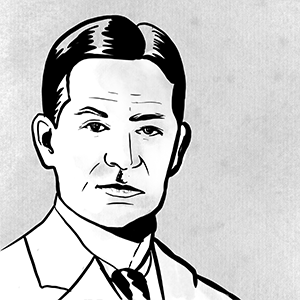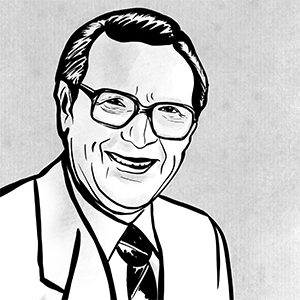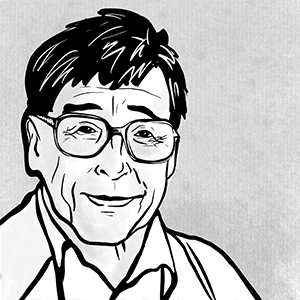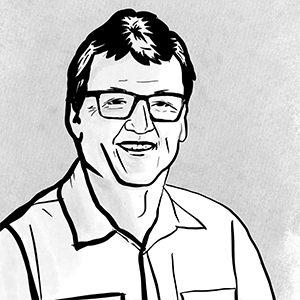![Drawing of all Nobel Laureats from University of Glasgow [Top row: left to right, William Ramsay, Frederick Soddy, John Boyd Orr, Alexander Todd. Bottom row: left to right, Derek Barton, James Black, Robert Edwards, David MacMillan.]](/media/Media_837500_smxx.jpg)
Our super 8
With Chemistry graduate Professor Sir David MacMillan receiving the Nobel Prize in Chemistry in 2021, we now have eight Nobel laureates associated with UofG, all shining examples of the world-changing researchers that have made an impact and built our reputation for hundreds of years.
 Sir William Ramsay (1852-1916)
Sir William Ramsay (1852-1916)
Nobel Prize in Chemistry 1904
Sir William Ramsay is renowned for discovering noble gases.
Born in Glasgow, he studied at the University between 1866 and 1870, before moving to Germany and gaining a PhD from the University of Tübingen. In 1874 he was appointed tutorial assistant in UofG’s Chemistry Department, and in 1880 was appointed Professor of Chemistry at University College, Bristol.
His work with the physicist Lord Rayleigh resulted in the discovery of argon in 1894, and he proceeded to find helium, neon, krypton and xenon, confirming a new group of elements in the periodic table: the noble gases. For their collaboration, William Ramsay and Lord Rayleigh each were awarded a Nobel Prize in 1904, in chemistry and physics respectively.
He went on to work with Glasgow graduate Frederick Soddy investigating radioactivity, and they provided experimental evidence for Rutherford's theory of radioactive disintegration.
Ramsay grease (a vacuum grease used as a lubrication and a sealant on laboratory glassware) is named after him.
 Frederick Soddy (1877-1956)
Frederick Soddy (1877-1956)
Nobel Prize in Chemistry 1921
Frederick Soddy was awarded the Nobel Prize in Chemistry for the discovery of isotopes.
He worked as a research assistant at Oxford until 1900, then spent two years at McGill University in Canada, lecturing in Chemistry and working with Sir Ernest Rutherford on radioactivity. He went on to work with Glasgow graduate William Ramsay at University College, London.
Soddy joined UofG as its first lecturer in Physical Chemistry & Radioactivity in 1904. While there, he carried out a demanding series of experiments which established the relationship between atomic numbers and periodic table position. His research led to him making the imaginative suggestion that elements with different atomic weights that did not seem separable by chemical means were indeed chemically identical. He proposed the name isotope, meaning equal place (in the periodic table).
He received the 1921 Nobel Prize in Chemistry for his research in radioactive decay and particularly for his formulation of the theory of isotopes.
A small crater on the far side of the Moon as well as the radioactive uranium mineral soddyite are named after him.
 John Boyd Orr, Baron Boyd Orr of Brechin (1880-1971)
John Boyd Orr, Baron Boyd Orr of Brechin (1880-1971)
Nobel Peace Prize 1949
John Boyd Orr was the first scientist to show a link between poverty, poor diet and ill health.
He qualified in teaching, medicine and physiological chemistry at UofG, before being appointed to head the Animal Nutrition Institute, later the Rowett Research Institute, Aberdeen.
In 1927, he proved the value of milk being supplied to school children, which led to free school milk provision in the UK. During the Second World War, he was a member of Churchill's Scientific Committee on Food Policy and helped to formulate food rationing. He went on to accept the post of director-general of the Food and Agriculture Organization of the United Nations. He set up an International Emergency Food Council to meet the post-war food crisis but his proposal for the establishment of a World Food Board failed in 1947.
In 1960, he was co-founder and first president of the World Academy of Art and Science, a scientific organisation concerned about the potential misuse of scientific discoveries, most especially nuclear weapons.
He was awarded the Nobel Peace Prize for "for his lifelong effort to conquer hunger and want, thereby helping to remove a major cause of military conflict and war” and he donated the entire financial award to organisations devoted to world peace and a united world government.
When he turned up for an interview to lead the Rowett Institute for Research in Animal Nutrition in Aberdeen on April Fool's Day 1914, he discovered that the Institute didn't actually exist, so he set about raising funds to build it.
 Sir Alexander Todd, Baron Todd of Trumpington (1907-1997)
Sir Alexander Todd, Baron Todd of Trumpington (1907-1997)
Nobel Prize in Chemistry 1957
Sir Alexander Todd's pioneering work on the structure of nucleic acids laid the foundations for research to establish the general formula of DNA.
He gained a BSc in Chemistry at UofG in 1928 and remained there one more year as a Carnegie Scholar before moving to Germany to continue his studies. In 1931 he was awarded a PhD degree in natural sciences, with a dissertation on the chemistry of bile acids.
He returned to Britain as the 1851 Exhibition Senior Student at Oxford and he went on to work as a researcher at the University of Edinburgh and the Lister Institute of Preventive Medicine, establishing his reputation as one of the country's leading organic chemists.
He was awarded the 1957 Nobel Prize in Chemistry for his work on the synthesis of nucleotides (the small units that make up the larger molecule of nucleic acids), the hereditary material of cells. This work led to many important advances in chemistry and biochemistry and made it possible to study the application of the Watson-Crick model of DNA and other nucleic acids more effectively.
In 2002, the country of Guyana issued a stamp (Scott No. 3699a) to honour him as a Nobel laureate.
 Sir Derek Barton (1918-1998)
Sir Derek Barton (1918-1998)
Nobel Prize in Chemistry 1969
Sir Derek Barton’s work on the concept of conformation in chemistry was groundbreaking.
Born in Kent, in 1938 he entered Imperial College, London, where he graduated in 1940 and obtained his PhD degree in Organic Chemistry in 1942. During the Second World War he worked on a research fellowship from the Distillers Co Ltd studying the synthesis of vinyl chloride and then in military intelligence. In 1945 he returned to Imperial College as a lecturer; he worked with ICI from 1946 until 1949 and was a Reader and then Professor of Organic Chemistry at Birkbeck College, from 1950 until his appointment as Regius Professor of Chemistry at UofG in 1955. In 1957 he was appointed Professor of Organic Chemistry at Imperial College.
In 1950, Barton showed that organic molecules could be assigned a preferred conformation based upon results accumulated by chemical physicists, in particular by Norwegian chemist Odd Hassel. Using this new technique of conformational analysis, he later determined the geometry of many other natural product molecules.
In 1969, Barton shared the Nobel Prize in Chemistry with Odd Hassel for "contributions to the development of the concept of conformation and its application in chemistry."
In 1977, on the occasion of the centenary of the Royal Institute of Chemistry, the British Post Office honoured him with a postage stamp featuring his discovery, worth 8.5 pence.
 Sir James Black (1924-2010)
Sir James Black (1924-2010)
Nobel Prize in Medicine 1988
Sir James Black’s invention of beta blockers was hailed as one of the most important drug discoveries of the century.
After graduating in Medicine from the University of St Andrews, Sir James Black became a lecturer in Malaya. He was appointed a lecturer at the University of Glasgow's Veterinary School in 1950 and established the Physiology Department there.
In 1958, he joined the pharmaceuticals company ICI and later worked for Smith, Kline & French and with the Wellcome Foundation. In 1973 he was appointed Professor of Pharmacology at University College, London and in 1978 he became Professor of Analytical Pharmacology at King's College, London, holding the Chair until 1992.
He was awarded the Nobel Prize in Medicine in 1988 for developing the drug propranolol, which is a beta blocker that has a calming effect on the heart by blocking the receptor for adrenaline, and for developing the drug cimetidine that suppresses the formation of gastric acid and is used to fight ulcers.
Black’s invention of the drug propranolol became the world's best-selling drug until he invented cimetidine, which was launched under the brand name Tagamet in 1975 and soon outsold propranolol to become the world's largest-selling prescription drug.
 Sir Robert Edwards (1925-2013)
Sir Robert Edwards (1925-2013)
Nobel Prize in Medicine 2010
Sir Robert Edwards and Patrick Steptoe developed the IVF technique for the fertilisation of human egg cells outside the body which led to the world's first test-tube baby in July 1978.
Sir Edwards began work on fertilisation in 1955. He was a Research Fellow in UofG’s Department of Biochemistry in 1962 to '63 and published a number of research papers with this affiliation.
His research partnership with gynaecologist surgeon Dr Patrick Steptoe began in 1968. Although the first successful human test-tube fertilisation took place by 1970, research did not result in a successful pregnancy for another eight years.
By the late 1970s, funding for Steptoe and Edwards' project was running out, and their work met with scepticism, resistance and setbacks. But in 1978, a breakthrough resulted in a healthy pregnancy and the birth of the first ever 'test-tube baby', Louise Brown.
Edwards and Steptoe went on to establish the first IVF clinic at Bourn Hall, Cambridge in 1980. Before Dr Steptoe died in 1988, Edwards, now a Professor of Human Reproduction at Cambridge, was able to tell his seriously ill colleague that one thousand babies had been conceived at the clinic.
At the time of his death in 2013 it was reported that more than four million births had resulted from IVF.
 Professor Sir David MacMillan (1968-)
Professor Sir David MacMillan (1968-)
Nobel Prize in Chemistry 2021
Glasgow graduate David MacMillan is the fifth Nobel laureate in Chemistry associated with UofG.
Born in Bellshill near Glasgow, David MacMillan received his undergraduate degree in chemistry at UofG. In 1990, he began his doctoral studies with Professor Larry Overman at the University of California, Irvine, before undertaking a postdoctoral position with Professor Dave Evans at Harvard University in 1996. He began his independent career at the University of California, Berkeley, in 1998 before moving to Caltech in 2000 as the Earle C Anthony Chair of Organic Chemistry.
In 2006, he moved to Princeton University as the A Barton Hepburn Professor of Chemistry. He served as Department Chair from 2010 to '15, and is currently the James S McDonnell Distinguished University Professor of Chemistry.
Dave shares the 2021 Nobel Prize in Chemistry with Benjamin List of the Max-Planck-Institut für Kohlenforschung “for the development of asymmetric organocatalysis”. Their discovery has helped make chemical processes more environmentally friendly and underpinned new methods of drug discovery.
Dave says he wouldn’t have gone to university if his brother Ian hadn’t gone there first, and that he wouldn’t have survived university without the support of his sister Lorraine.
This article was first published March 2022 and updated June 2022.
WORLD CHANGING ALUMNI AWARD
This is a prestigious annual University honour which recognises and celebrates the achievements of alumni who have made a major contribution to the community, arts, science or business. It has been presented to a world-changing alumnus every year since 2001.

